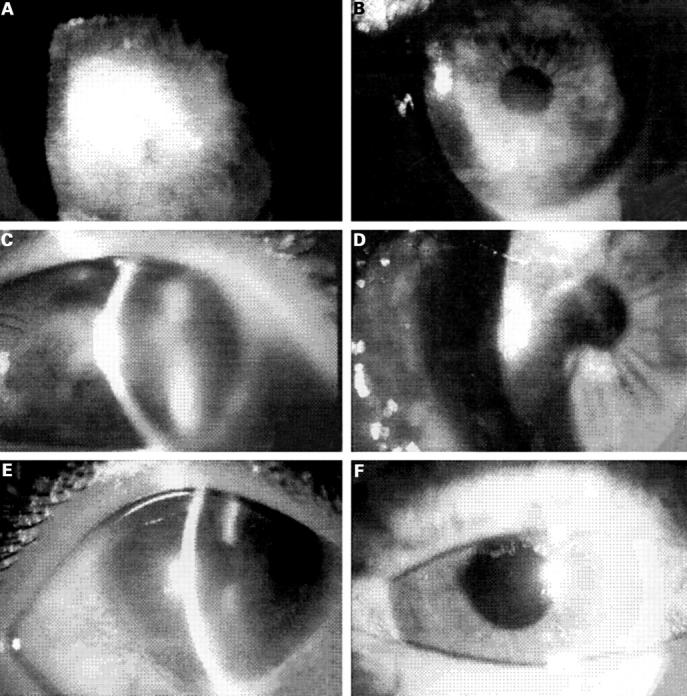Abstract
BACKGROUND/AIM—Chemical ocular burn, especially by alkali, may result in damage to the limbal stem cells, fundamental in maintaining the integrity of ocular surface. Clinically, patients manifest abnormal conjunctival-corneal healing with peripheral neovessels, chronic epithelial defect, severe stromal inflammation, and conjunctivalisation of the corneal, which is characteristic of limbal deficiency. Penetrating keratoplasty has a poor prognosis in these cases. Available therapeutic options included limbal autograft and allograft transplantation associated or not with human amniotic membrane transplant. The authors propose an alternative treatment with ipsilateral autologous limbal transplantation, transferring the healthy portion of the limbus from the partially burned eye to the deficient area in patients with partial limbal deficiency secondary to alkali burn. METHODS—Ipsilateral limbal autografts were performed in five patients with partial limbal deficiency secondary to alkali burn, transferring the healthy portion of the limbus to the burned area of the same eye, without intervening in the contralateral eye. RESULTS—All cases had regression of the limbal deficiency with improvement of visual acuity to a minimum of 20/60-20/20 (partial), without complications during the follow up period (range 7-11 months). CONCLUSION—Ipsilateral autologous limbal autograft is a therapeutic option for partial limbal deficient eyes.
Full Text
The Full Text of this article is available as a PDF (127.2 KB).
Figure 1 .

Preoperative and postoperative photographic sequence of three patients undergoing ILT. (A) Patient 1 with 4+ conjunctival hyperaemia, central epithelial defect, corneal oedema, neovascularisation, and BCVA of hand movements. (B) Same patient 11 months after ILT. Stable ocular surface and BCVA of 20/40. (C) Patient 2 presenting with diffuse conjunctival hyperaemia and corneal opacity with epithelial oedema, neovascularisation, and severe stromal oedema. BCVA was hand movements. (D) Same patient 10 months after ILT. BCVA was 20/60. (E) Patient 3 presenting epithelial defect, corneal oedema, and stromal opacity compromising the third inferior section of the cornea. BCVA was 20/80. (F) Nine months after ILT BCVA was 20/20.
Selected References
These references are in PubMed. This may not be the complete list of references from this article.
- Brown S. I., Bloomfield S. E., Pearce D. B. A follow-up report on transplantation of the alkali-burned cornea. Am J Ophthalmol. 1974 Apr;77(4):538–542. doi: 10.1016/0002-9394(74)90468-1. [DOI] [PubMed] [Google Scholar]
- Chen J. J., Tseng S. C. Abnormal corneal epithelial wound healing in partial-thickness removal of limbal epithelium. Invest Ophthalmol Vis Sci. 1991 Jul;32(8):2219–2233. [PubMed] [Google Scholar]
- Coster D. J., Aggarwal R. K., Williams K. A. Surgical management of ocular surface disorders using conjunctival and stem cell allografts. Br J Ophthalmol. 1995 Nov;79(11):977–982. doi: 10.1136/bjo.79.11.977. [DOI] [PMC free article] [PubMed] [Google Scholar]
- Huang A. J., Tseng S. C. Corneal epithelial wound healing in the absence of limbal epithelium. Invest Ophthalmol Vis Sci. 1991 Jan;32(1):96–105. [PubMed] [Google Scholar]
- Kenyon K. R., Tseng S. C. Limbal autograft transplantation for ocular surface disorders. Ophthalmology. 1989 May;96(5):709–723. doi: 10.1016/s0161-6420(89)32833-8. [DOI] [PubMed] [Google Scholar]
- Kim J. C., Tseng S. C. Transplantation of preserved human amniotic membrane for surface reconstruction in severely damaged rabbit corneas. Cornea. 1995 Sep;14(5):473–484. [PubMed] [Google Scholar]
- Kruse F. E. Stem cells and corneal epithelial regeneration. Eye (Lond) 1994;8(Pt 2):170–183. doi: 10.1038/eye.1994.42. [DOI] [PubMed] [Google Scholar]
- Ronk J. F., Ruiz-Esmenjaud S., Osorio M., Bacigalupi M., Goosey J. D. Limbal conjunctival autograft in a subacute alkaline corneal burn. Cornea. 1994 Sep;13(5):465–468. doi: 10.1097/00003226-199409000-00017. [DOI] [PubMed] [Google Scholar]
- Schermer A., Galvin S., Sun T. T. Differentiation-related expression of a major 64K corneal keratin in vivo and in culture suggests limbal location of corneal epithelial stem cells. J Cell Biol. 1986 Jul;103(1):49–62. doi: 10.1083/jcb.103.1.49. [DOI] [PMC free article] [PubMed] [Google Scholar]
- Tan D. T., Ficker L. A., Buckley R. J. Limbal transplantation. Ophthalmology. 1996 Jan;103(1):29–36. doi: 10.1016/s0161-6420(96)30737-9. [DOI] [PubMed] [Google Scholar]
- Thoft R. A. Conjunctival transplantation. Arch Ophthalmol. 1977 Aug;95(8):1425–1427. doi: 10.1001/archopht.1977.04450080135017. [DOI] [PubMed] [Google Scholar]
- Tsai R. J., Tseng S. C. Human allograft limbal transplantation for corneal surface reconstruction. Cornea. 1994 Sep;13(5):389–400. doi: 10.1097/00003226-199409000-00003. [DOI] [PubMed] [Google Scholar]
- Tseng S. C. Concept and application of limbal stem cells. Eye (Lond) 1989;3(Pt 2):141–157. doi: 10.1038/eye.1989.22. [DOI] [PubMed] [Google Scholar]
- Tsubota K., Toda I., Saito H., Shinozaki N., Shimazaki J. Reconstruction of the corneal epithelium by limbal allograft transplantation for severe ocular surface disorders. Ophthalmology. 1995 Oct;102(10):1486–1496. doi: 10.1016/s0161-6420(95)30841-x. [DOI] [PubMed] [Google Scholar]


